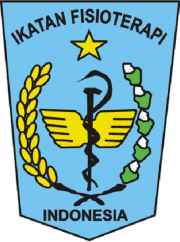HUBUNGAN DERAJAT QUADRICEPS ANGLE DENGAN PATELLA FEMORAL PAIN
Adnan Faris Naufal(1*), Dini Afriani Khasanah(2), Ulfa Noviyana(3)(1) Department of Physiotherapy, Universitas Muhammadiyah Surakarta
(2)
(3)
(*) Corresponding Author
Abstract
Petellofemoral pain syndrome (PFPS) tidak memiliki definisi yang jelas tentang bagaimana gejala dan letak nyeri yang dirasakan seseorang yang mengalaminya. Diketahui PFPS memiliki hubungan terhadap besar sudut otot quadriceps atau Q angle. Namun masalahnya masih belum spesifik berapa besar Q-angle yang memiliki resiko terhadap PFPS. Penelitian ini dimaksudkan untuk mencari tahu hubungan antara besar q-angle dengan resiko PFPS. Untuk mngetahui adanya PFPS dapat dilakuka dengan Clarke's test, sedangkan untuk mengukur besar sudut Q-angle diukur dengan goniometer. Subyek penelitian mengambil dari pemain basket Universitas Muhammadiyah Surakarta. Data yang dikumpulkan kemudian dianalisis menggunakan uji Spearman Rho. Hasil penelitian menunjukan adanya hubungan Q-angle dan patellafemoral pain syndrome pada pemain bola basket wanita. Nilai p value dari Q-angle sebesar 0,024 sehingga Ho ditolak dengan nilai r = 0,579 menunjukan hubungan positif dan kekuatan korelasi yang tinggi, patellofemoral pain syndrome 0,043 dengan nilai r = 0,528 menunjukan hubungan positif dan kekuatan korelasi yang kuat. Hasil penelitian ini menunjukkan terdapat hubungan Q-angle terhadap keluhan patellofemoral pain syndrome.
Full Text:
PDFReferences
Naufal, A. . F., Khasanah, D. A. & Noviyana, U., 2020. Hubungan Derajat Quadriceps Angle Dengan Patella Femoral Pain. Fisiomu, 1(1), pp. 29-34.
Petersen W, Rembitzki, Liebau C. Patellofemoral pain in athletes. Open access journal of sports medicine. 2017;8, 143–154. doi:10.2147/OAJSM.S133406
Foss KD, Myer GD, Magnussen RA. Hewett TE. Diagnostic Differences for Anterior Knee Pain between Sexes in Adolescent Basketball Players. Journal of athletic enhancement. 2014; 3(1), 1814. doi:10.4172/2324-9080.1000139
Barber KD, Myer GD, Chen SS, Hewett TE. Expected prevalence from the differential diagnosis of anterior knee pain in adolescent female athletes during preparticipation screening. Journal of athletic training. 2012; 47(5), 519–524. doi:10.4085/1062-6050-47.5.01
Türkmen, F., Acar, M. A., Kacıra, B. K., Korucu, İ. H., Erkoçak, Ö. F., Yolcu, B., & Toker, S. (2015). A new diagnostic parameter for patellofemoral pain. International journal of clinical and experimental medicine, 8(7), 11563–11566.
Freedman, B. R., Brindle, T. J., & Sheehan, F. T. (2014). Re-evaluating the functional implications of the Q-angle and its relationship to in-vivo patellofemoral kinematics. Clinical biomechanics (Bristol, Avon), 29(10), 1139–1145. doi:10.1016/j.clinbiomech.2014.09.012
Boling, M. C., Padua, D. A., Marshall, S. W., Guskiewicz, K., Pyne, S., & Beutler, A. (2009). A prospective investigation of biomechanical risk factors for patellofemoral pain syndrome: the Joint Undertaking to Monitor and Prevent ACL Injury (JUMP-ACL) cohort. The American journal of sports medicine, 37(11), 2108–2116. doi:10.1177/0363546509337934
Ferber, R., Kendall, K. D., & Farr, L. (2011). Changes in knee biomechanics after a hip-abductor strengthening protocol for runners with patellofemoral pain syndrome. Journal of athletic training, 46(2), 142–149. doi:10.4085/1062-6050-46.2.142
Arazpour, M., Bahramian, F., Abutorabi, A., Nourbakhsh, S. T., Alidousti, A., & Aslani, H. (2016). The Effect of Patellofemoral Pain Syndrome on Gait Parameters: A Literature Review. The archives of bone and joint surgery, 4(4), 298–306.
Smith T.O., Hunt N.J., Donell S.T. (2008). The reliability and validity of the Q-angle: a systematic review. Knee Surg Sports Traumatol Arthrosc. 16(12):1068–1079.
Ittenbach RF, Huang G, Barber Foss KD, Hewett TE, Myer GD. Reliability and Validity of the Anterior Knee Pain Scale: Applications for Use as an Epidemiologic Screener. PLoS One. 2016;11(7):e0159204. Published 2016 Jul 21. doi:10.1371/journal.pone.0159204
Halabchi F, Abolhasani M, Mirshahi M, Alizadeh Z. Patellofemoral pain in athletes: clinical perspectives. Open Access J Sports Med. 2017;8:189–203. Published 2017 Oct 9. doi:10.2147/OAJSM.S127359
Robinson R.L., Nee R.J. (2007). Analysis of hip strength in females seeking physical therapy treatment for unilateral patellofemoral pain syndrome. J Orthop Sports Phys Ther. 37(5):232–238.
Vora, M., Curry, E., Chipman, A., Matzkin, E., & Li, X. (2018). Patellofemoral pain syndrome in female athletes: A review of diagnoses, etiology and treatment options. Orthopedic reviews, 9(4), 7281. doi:10.4081/or.2017.7281
Besier TF, Pal S, Draper CE, et al. The Role of Cartilage Stress in Patellofemoral Pain. Med Sci Sports Exerc. 2015;47(11):2416–2422. doi:10.1249/MSS.0000000000000685
Zaffagnini S, Dejour D, Grassi A, et al. Patellofemoral anatomy and biomechanics: current concepts. Joints. 2013;1(2):15–20. Published 2013 Oct 24.
Amis AA, Senavongse W, Bull AM. Patellofemoral kinematics during knee flexion-extension: an in vitro study. J Orthop Res. 2006;24:2201–2211.
Article Metrics
Abstract view(s): 546 time(s)PDF: 850 time(s)
Refbacks
- There are currently no refbacks.







